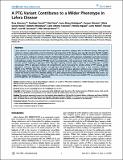Por favor, use este identificador para citar o enlazar a este item:
http://hdl.handle.net/10261/37651COMPARTIR / EXPORTAR:
 SHARE SHARE
 CORE
BASE CORE
BASE
|
|
| Visualizar otros formatos: MARC | Dublin Core | RDF | ORE | MODS | METS | DIDL | DATACITE | |

| Título: | A PTG Variant Contributes to a Milder Phenotype in Lafora Disease |
Autor: | Guerrero, Rosa; Vernia, Santiago CSIC ORCID ; Sanz, Raúl; Abreu-Rodríguez, Irene; Almaraz, Carmen; García-Hoyos, María; Michelucci, Roberto; Tassinari, Carlo Alberto; Riguzzi, Patrizia; Nobile, Carlo; Sanz, Pascual CSIC ORCID ; Serratosa, José M.; Gómez-Garre, Pilar CSIC ORCID | Fecha de publicación: | 30-jun-2011 | Editor: | Public Library of Science | Citación: | PLoS ONE 6(6): e21294 (2011) | Resumen: | Lafora disease is an autosomal recessive form of progressive myoclonus epilepsy with no effective therapy. Although the outcome is always unfavorable, onset of symptoms and progression of the disease may vary. We aimed to identify modifier genes that may contribute to the clinical course of Lafora disease patients with EPM2A or EPM2B mutations. We established a list of 43 genes coding for proteins related to laforin/malin function and/or glycogen metabolism and tested common polymorphisms for possible associations with phenotypic differences using a collection of Lafora disease families. Genotype and haplotype analysis showed that PPP1R3C may be associated with a slow progression of the disease. The PPP1R3C gene encodes protein targeting to glycogen (PTG). Glycogen targeting subunits play a major role in recruiting type 1 protein phosphatase (PP1) to glycogen-enriched cell compartments and in increasing the specific activity of PP1 toward specific glycogenic substrates (glycogen synthase and glycogen phosphorylase). Here, we report a new mutation (c.746A>G, N249S) in the PPP1R3C gene that results in a decreased capacity to induce glycogen synthesis and a reduced interaction with glycogen phosphorylase and laforin, supporting a key role of this mutation in the glycogenic activity of PTG. This variant was found in one of two affected siblings of a Lafora disease family characterized by a remarkable mild course. Our findings suggest that variations in PTG may condition the course of Lafora disease and establish PTG as a potential target for pharmacogenetic and therapeutic approaches | Descripción: | 9 pages, 6 figures, PMID:21738631[PubMed] | Versión del editor: | http://dx.doi.org/10.1371/journal.pone.0021294 | URI: | http://hdl.handle.net/10261/37651 | DOI: | 10.1371/journal.pone.0021294 | E-ISSN: | 1932-6203 |
| Aparece en las colecciones: | (IBV) Artículos (IBIS) Artículos |
Ficheros en este ítem:
| Fichero | Descripción | Tamaño | Formato | |
|---|---|---|---|---|
| Plos One 2011.pdf | 1,24 MB | Adobe PDF |  Visualizar/Abrir |
CORE Recommender
PubMed Central
Citations
12
checked on 20-abr-2024
SCOPUSTM
Citations
26
checked on 16-abr-2024
WEB OF SCIENCETM
Citations
25
checked on 22-feb-2024
Page view(s)
388
checked on 22-abr-2024
Download(s)
255
checked on 22-abr-2024
Google ScholarTM
Check
Altmetric
Altmetric
Artículos relacionados:
NOTA: Los ítems de Digital.CSIC están protegidos por copyright, con todos los derechos reservados, a menos que se indique lo contrario.
